Marketing summary
Chapter 1
Marketing orientation: a marketing-oriented organization devotes resources to understanding the
needs and buying behavior of customers, competitors’ activities and strategies, and of market trends
and external forces – now and as they may shape up in the future. Inter-functional coordination across
the company ensures that the organization’s activities and capabilities are aligned to this marketing
intelligence. Not all organizations can claim to have a marketing orientation.
Marketing: activities that facilitate and expedite satisfying exchange relationships in a dynamic
environment, through the creation, distribution, promotion and pricing of goods, services and ideas.
Marketing is a function and a set of processes for creating, communicating and delivering value to
customers and for managing customer relationships in ways that benefit the organization and its
stakeholders.
Marketing environment: external changing forces within the trading environment: laws, regulations,
political activities, societal pressures, economic conditions and technological advances.
Marketing depends on the successful analysis of customers, the marketing environment, competition,
internal capabilities and performance.
The ultimate goal of marketing is creating value.
Four conditions for an exchange:
- Two or more individuals, groups or organizations must participate
- Each party must possess something of value that the other party desires
- Each party must be willing to give up its ‘something of value’ to receive ‘something of value’
held by the other party
Customer satisfaction: a state that results when an exchange meets the needs and expectations of the
buyer. Without satisfaction, customers are unlikely to return.
Different types of products:
- Good: physical entity that can be touched
- Service: the application of human and mechanical efforts to people or objects in order to
provide intangible benefits to customers
- Idea: a concept, philosophy, image or issue
Marketing process: the analysis of market conditions, the creation of an appropriate marketing
strategy, the development of marketing programmes designed to action the agreed strategy and,
finally, the implementation and control of the marketing strategy and its associated marketing
programmes. Steps in the marketing process:
- Marketing analysis: finding out opportunities, threats and market insights
- Marketing strategy: trade-off choice: priorities to pursue and compelling proposition
- Marketing programmes: customer engagement: attraction and retention
- Marketing controls: execution: controls, audits and remedial activities
Marketing concept: the philosophy that an organization should try to provide products that satisfy
customers’ needs through a coordinated set of activities that also allows the organization to achieve its
goals.
The evolution of the marketing concepts:
- Production era: the period of mass production following industrialization
- Sales era: the period from the mid-1920s to the early 1950s when competitive forces and the
desire for high sales volume led a company to emphasize selling and the sales person in its
business strategy
1
, - Marketing era: the period in which product and aggressive selling were no longer seen to
suffice if customers either did not desire a product or preferred a rival brand, and in which
customer needs were identified and satisfied
- Relationship marketing era: in which the focus is not only on expediting the single transaction
but on developing ongoing relationships with customers to maintain lifetime share of wallet
- Digital era: now the focus is on managing customer relationships. developing customer
insight and building a brand online
With this came a growth in consumer-to-consumer (C2C) communication: consumers readily
and rapidly share views, experiences and information with each other. A positive or negative
customer experience is tweeted instantly, blogged or shared on Facebook with potentially very
many fellow consumers.
There is also more social marketing: uses tools and techniques form commercial marketing to
make interventions which encourage positive behavioral changes, such as quitting smoking,
reducing alcohol consumption, improving fitness, minimizing anti-social behaviors or
reducing carbon footprint; to enhance the health and well-being of individuals, society and the
planet.
There is also more critical marketing: involves challenging orthodox views that are central to
the core principles of the discipline. Sometimes this involves promoting radical philosophies
and theories in relation to the understanding of economies, society, markets and consumers,
which may have implications for the practice of marketing. Critical marketing is connected
with the growing area of critical management.
Marketing needs to analyze:
- Customers
- Competitors
- Marketing environment forces
- The organization’s capabilities and marketing assets
- Performance
Marketing strategy: the selection of new opportunities to pursue and current acitivites to maintain,
identification of associated target amrkets and competitive positioning, and the creation of appropriate
customer value propositions and engagement plans, in order to deliver the specified performance goals
in the corporate strategy.
Three sets of variables in the marketing strategy:
- Those relating to the marketing mix
- Those inherent in the accompanying target market strategy
- Those that make up the marketing environment
[figure 1.4, page 24]
Marketing opportunity: one that exists when timing and circumstances allow an organization to take
actions towards reaching a particular group of consumers or business customers in order to develop
relationships and achieve commercial goals. Marketers should be capable of recognizing and
analyzing marketing opportunities.
Ways in which marketing environment forces affect a marketer’s ability to facilitate and expedite
exchanges:
- Forces influence customers by affecting or regulating their lifestyles, standards of living,
preferences and needs for products.
- Forces help determine whether and how a marketing managers can perform certain marketing
activities
- Forces may affect a marketing manager’s decisions and actions by influencing buyers’
reactions to the company’s marketing mix
- Forces may provide an organization with a window of opportunity over rivals that fail to
notice the market development or that take no action themselves
2
, A target market must be selected for marketing. Target market: a group of people or organizations for
whom a company creates and maintains a marketing mix that specifically fits the needs and
preferences of that group. Target market selection is crucial to generating productive marketing
efforts.
The marketing mix: the tactical ‘toolkit’ of the marketing programme:
- Product: the aspect of the marketing mix that deals with researching consumers’ product
wants and designing a product with the desired characteristics and functionality
- Place/distribution: the aspect of the marketing mix that deals with making products available,
perhaps through multiple channels, in the quantities desired, to as many customers as possible,
while keeping the total inventory, transport and storage costs as low as possible
- Promotion (marketing communications): the aspect of the marketing mix that relates to
marketing communications used to inform one or more groups of people about an
organization and its products and to maintain an ongoing relationship
- Price: the aspect of the marketing mix that relates to activities associated with establishing
pricing policies and determining product prices
- People: the aspect of the marketing mix that reflects the level of customer service, advice,
sales support and after-sales back-up required, involving recruitment policies, training,
retention and motivation of key personnel
Marketing management: the process of planning, organizing, implementing and controlling marketing
activities to facilitate and expedite exchanges effectively and efficiently
Marketing planning: a systematic process of assessing marketing opportunities and resources,
determining marketing objectives and developing a thorough plan for implementation and control.
The marketing control process consists of establishing performance standards, evaluating performance
by comparing it with established standards and reducing the difference between desired and actual
performance. Requirements for an effective control:
- Ensure a rate of information flow
- Accurately monitor different kinds of activities
- Be economical so that its costs are low
- Designed so that both managers and subordinates can understand it
Chapter 2
Marketing strategy: the select5ion of new opportunities to pursue and current activities to continue to
support, identification of associated target markets and competitive positioning, and the creation of
appropriate value propositions and customer engagement plans, in order to deliver the specified
performance goals in the corporate strategy. Activities of marketing strategy:
- Creating an awareness of performance
- The identification and assessment of new opportunities to pursue and the selection of the
overall mix of existing and new activities to support
- The creation of an associated target market strategy
- Development of a competitive advantage
- Communication of a compelling value proposition and brand positioning
- Effective consumer or business customer engagement and retention
- The execution of appropriate marketing programs
- The management of this implementation with appropriate resources, controls and benchmarks.
Strategy; the direction and scope of an organization over the longer-term, which achieves advantage
for the organizations through its configuration of resources within a challenging environment, to meet
the needs of markets and to fulfil stakeholder or shareholder expectations. Components of strategy:
- Direction
- Scope
- Advantage
- Resources
3






